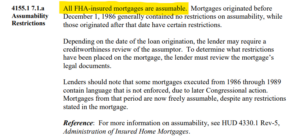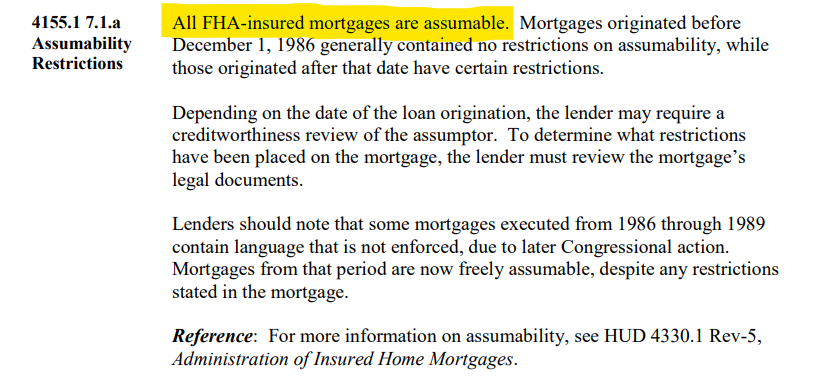 Let’s suppose you’re behind on your payments or in danger of missing a payment. You probably aren’t underwater in this market, but it may be time to sell. It’s not hard to find a buyer (or five) these days, but sellers still have some worries about their buyer getting their mortgage commitment. Rates are relatively high, so it’s understandable for a little anxiety about a buyer performing, especially when you NEED to sell.
Let’s suppose you’re behind on your payments or in danger of missing a payment. You probably aren’t underwater in this market, but it may be time to sell. It’s not hard to find a buyer (or five) these days, but sellers still have some worries about their buyer getting their mortgage commitment. Rates are relatively high, so it’s understandable for a little anxiety about a buyer performing, especially when you NEED to sell.
This might be a helpful thing to know: If you have a government-insured loan like an FHA, VA, or USDA mortgage, your buyer may be able to assume your payments. There are some significant advantages to an assumable mortgage.
Here’s what’s in it for the buyer:
- Lower rate. If your mortgage was originated before 2023, the rate your buyer would assume is significantly lower than the rates they are being quoted now. If you are paying, for example, 3.5%, your buyer would be eager to have that rate because their payment would be far lower than a 7% loan.
- Lower closing costs. Assumptions save the buyer on transfer taxes and other fees.
- No appraisal hazards. One of the things that can kill a deal is an under-appraisal. That isn’t the case with an assumption, because it isn’t a new loan. No matter how much the buyer pays over asking price, the lender just requires 96.5% loan to value, which is far higher than what your buyer will have in almost every case.
- Shorter loan term. If your mortgage was originated in 2020, for example, the buyer would only have 26 years remaining on a 30-year mortgage.
I think you may get the picture. But here’s what is in it for the seller, even if they are behind on their payments. Having an assumable mortgage makes a property far more attractive to buyers, because it is an opportunity for them to get a home with a rate below 6% -and often far lower, even below 3% in some cases- in a world where 7% is the norm.
More demand for a house with this type of loan means the seller may get a far higher price.
I’ll sketch out an example that is rooted in an active listing I know of. The seller bought the home in 2020 for $375,000. The current price is $425,000. The mortgage balance is roughly $350,000. The interest rate is 2.4%. In this scenario, the buyer pays the seller $75,000 and owns the house just like any other purchase and assumes the payments. The principal and interest payment on a new mortgage would be $2,329 at a 7% interest rate. But if they assumed the mortgage their principle and interest would be $1,365.
Not only would they have a lower payment, if they lived there for 30 years they’d avoid 48 mortgage payments, saving them over $100,000.
Not all mortgages are assumable. Only FHA, VA and USDA mortgage are, with rare exception. Moreover, even if a house has a government insured mortgage the balance may be too low to assume with just a down payment. However, a small second mortgage could solve that challenge.
It’s important to note that the lender has to approve the assumption, because no loans originated since 1989 are freely assumable. However, if you are preapproved at 7% now, approval on a lower rate should be easier, all things being equal.
There are millions of assumable mortgages out there, so while this isn’t a hen’s tooth in my backyard here in Westchester County, this opportunity is not common. You should consult with your lawyer, your financial advisor, and have a good buyer agent on this.
Even if you are behind on your payments, an assumption could be feasible depending on the arrearage and market value. I will say this: with all my short sale experience, I have not seen a house underwater in a very long time. So if you have an assumable mortgage and are experiencing distress, you may have an exit strategy that can make your sale more expeditious than a typical homeowner.


